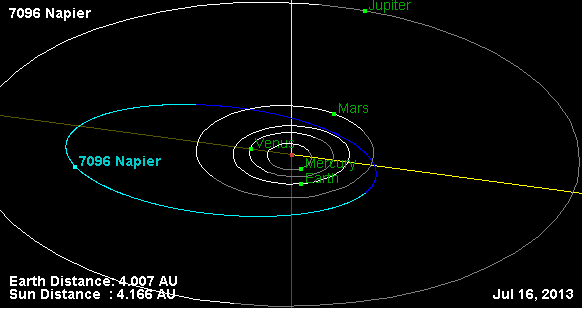The first asteroids discovered in the early 1800’s were named after Roman and Greek mythological figures like Ceres, Pallas, and Vesta. Today, most asteroids are named after people, both real and fictional, places, animals, plants, and other natural phenomena. The discoverers of asteroids are responsible for proposing the name however there are rules. The rules for naming are managed by the Minor Planet Center which is run out of the Smithsonian Astrophysical Observatory in Massachusetts and overseen by the International Astronomical Union.

Credit: NASA
When a new asteroid is first discovered, the Minor Planet Center gives it a provisional designation of the the year of discovery and two numbers. If astronomers successfully confirm its orbit it will get a permanent numeral designation that corresponds with the object’s place on the chronological list of previous discoveries. The discoverer then has 10 years to suggest and submit a name for the object, including a short pitch for why the name should be accepted. A 15-person committee at the International Astronomical Union judges the name and will either approve or deny.
Rules for names include that it should be: 16 characters or less in length, preferably one word, pronounceable (in some language), non-offensive, and not too similar to an existing name of an asteroid. There are guidelines for certain kinds of asteroids. Objects that cross or approach the orbit of Neptune, for example, must be named after mythological figures associated with the underworld, while objects right outside of Neptune’s orbit get named after mythological figures related to creation.
Asteroids can’t be named after pets, but there has been at least one approved, perhaps because the cat was named after a Star Trek character. In 1985, an astronomer received approval to name his asteroid Mr. Spock after the cat that had kept him company during long hours at work.
Finally, discoverers can’t sell the chance to name their asteroid, however naming contests are allowed. In 2012, NASA ran a contest to name (101955) 1999 RQ36, a near-Earth asteroid and the target of the robotic mission OSIRIS-REx. They picked the name Bennu, the Egyptian mythological bird resembling a heron.

Credit: NASA
Did you know that there are asteroids out there named by and after Armagh Observatory and Planetarium staff?
(2099) Opik
American Astronomer Eleanor F. Helin named her discovery in honour of Ernst J. Opik. Opik was the Director of Armagh Observatory between 1948–1981. This asteroid is described as a dark, eccentric and Mars-crosser from the inner regions of the asteroid belt and is approx. 5.1 km in diameter.

(4050) Mebailey
Swedish astronomers Claes-Ingvar Lagerkvist and Hans Rickman named their discovery after Mark Bailey who was a Director of Armagh Observatory. This asteroid is located in the asteroid belt.
(9084) Achristou
Discovered by Armagh Observatory astronomer David Asher in 1995 it was named after of another AOP astronomer Apostolos Christou. This asteroid is a stony Hungaria from the innermost regions of the asteroid belt and is about 1.9 km in diameter.
(6564) Asher
Scottish-Australian astronomer Robert H. McNaught named this asteroid after David Asher, an astronomer at AOP.

(7096) Napier
Discovered in 1992, Robert H. McNaught named this Mars-crossing asteroid after William M. Napier, the Scottish astronomer who has worked at Armagh Observatory.

(9920) Bagnulo
This is a main belt asteroid which orbits the Sun once every 4.65 years and is a member of the Hoffmeister family of asteroids. It was discovered in 1981 by American astronomer Schelte Bus and named after AOP astronomer Stefano Bagnulo.
(10502) Armaghobs
American astronomer Eleanor F. Helin also named her discovery of an eccentric, rare-type stony asteroid and Mars-crosser from the inner regions of the asteroid belt after Armagh Observatory. It is approximately 2.6 km in diameter and was discovered in 1987 at the Palomar Observatory in California.

(14274) Landstreet
This asteroid was discovered in 2000 by Spacewatch at Kitt Peak. It was named after John Darlington Landstreet who worked at Armagh Observatory. Landstreet helped discover magnetic fields in white dwarf stars and developed Balmer-line polarimetry for detection of magnetic fields in middle-main sequence stars.
There are lots of asteroids out there and remember if you find one you will have the privilege of suggesting a name for it. So, if you would love to have your name used for an asteroid discovery or have a unique name you would like to use, the best advice is to go out and discover an asteroid!
Happy asteroid hunting!



1 Comment
How to name an Asteroid - Virtual Orbit · December 7, 2020 at 16:52
[…] How to name an Asteroid […]